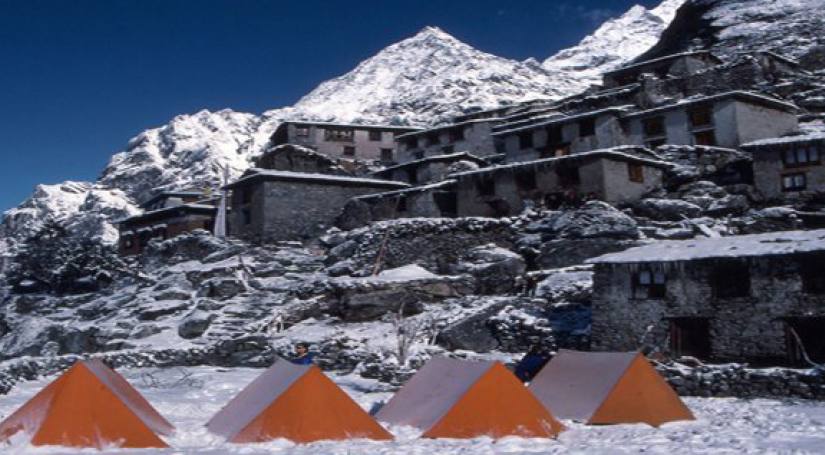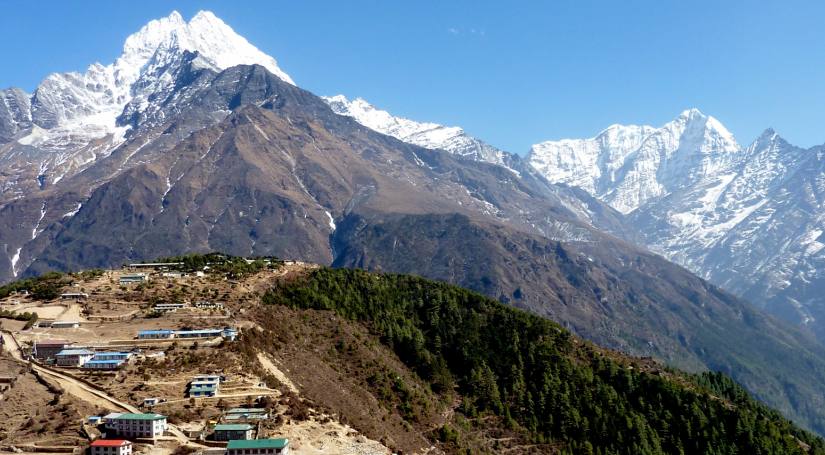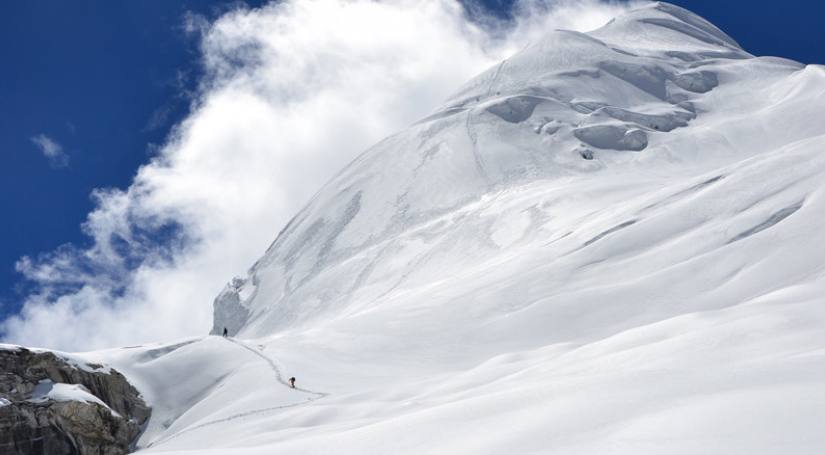Rolwalling Trek - 17 Days
An adventurous Rolwaling trek is a remote and less explored mountain trail of Nepal. The trail offers amazing Rolwaling valley linked with world’s popular Khumbu valley in the Everest region of Nepal. Highlights of the Rolwaling trek includes crossing of one of the adventurous Tashi Lapcha Pass in 5755 meters which is located at the base of Pachherom Peak, Ramdong peak and other snowcapped peaks in surroundings. Most of the time, the pass contains snows and ices so the trek can be considered as a one of the tough trail. The trek is very suitable for those adventure motivated seekers who wants to explore less the beaten trail coupled with world’s famous Everest Base Camp Trail.
A professionally organized Rolwaling Trek with Junket Nepal Pvt.Ltd embarks after a day sightseeing tour in Kathmandu valley. Leaving Kathmandu, we will have a full day drive to Gongar Khola – the exact starting point of our trek. Then we start following zigzag ascends and descends towards gradually Simigaun, Dovan, Beding and Na village by crossing several cultural villages, rice terraces, green hills, jungles and often view of Mt. Gourishankar. While making the perfect adventure holiday of Rolwaling Trek, we will take a reserve day in Na village to be properly acclimatized with altitudes. Then, we gradually ascend towards beautiful glacier lake of Tsho Rolpa and amazing Drolombu glacier. Again, we follow steep snow section & rocky trails to cross our main pass of the entire trek Tashi Lapcha from where we can have close up views of several snowcapped peaks. After crossing the pass, the trail dramatically follows gradual downhill to Tyangbo Kharka then to Sherpa Kingdom Namche Bazaar. Next, we descend to Lukla and fly back to Kathmandu to conclude wonderful Rolwaling Trek experience with Junket Nepal Pvt.Ltd.
Outline Itinerary
- Day 01: Arrive at Kathmandu and transfer to Hotel.
- Day 02: Sightseeing tour in Kathmandu
- Day 03: Drive to Gongar Khola (1,350m altitude) 7-8 hrs
- Day 04: Trek to Simigaun (2,000m altitude) 4-5 hrs
- Day 05: Trek to Dovan (2,850m altitude) 5-6 hrs
- Day 06: Trek to Beding (3,690m altitude) 5-6 hrs
- Day 07: Trek to Na Village (4,180m altitude) 3-4hrs
- Day 08: Rest at Na Village for acclimatization and local hike.
- Day 09: Trek to Tsho Rolpa Lake (4,560m altitude) 4-5 hrs
- Day 10: Trek to Drolambu Glacier (4,880m altitude) 5-6 hrs
- Day 11: Cross Tashi Lapcha Pass (5,755m altitude) and trek to Campsite. 6-7 hrs
- Day 12: Trek to Thyangbo Kharka(4,320m altitude) 5-6 hrs
- Day 13: Trek to Namche Bazaar (3,450m altitude) 5-6 hrs
- Day 14: Trek to Lukla (2,800m altitude) 5-6 hrs
- Day 15: Fly from Lukla to Kathmandu
- Day 16: Free day in Kathmandu
- Day 17: Final Departure
Cost Includes:
- Airport Arrival and departure transfer by Private Vehicle
- Accommodation in Kathmandu with BB Plan (3 star rated hotel) as per itinerary
- A day guided sightseeing tour in Kathmandu including City Guide, Private Vehicle and all heritage sites entrance fees
- All ground transportation (as per mentioned in Itinerary) by private vehicle
- All required Trekking permits and conservation area fees
- Tea House + Camping accommodation (as per availability) during the trek as per mentioned in itinerary
- All meals during the entire trek
- Trekking guide
- Required numbers of porters
- Lukla – Kathmandu Flight
- Staffs salary, clothing and insurance
- Government tax/vat and required documentations
Cost Excludes:
- Personal travel insurance
- Major meals in cities
- Personal expenses such as laundry, bar bill etc.
- Personal trekking stuffs
- TIPS for staffs
Outline Itinerary
Usefull Info
Trekking preparation and Physical Condition:
Physical Fitness is an important part to have trekking adventure in Nepalese Himalayas. To be fully prepared to gain lifetime experience of walking in the mountains, explore Himalayan vista with combined cultural experience can accomplished by exploit inspired adventure seekers who can walk 4 to 6 hours ascends and descends per day. We generally prefer short and easy trek for first time trekkers and moderate to adventurous trekking for experienced trekkers as per preferences.
Preparation for trekking has not any hard and fast rules and regulations. We recommend all trekkers to maintain their physical fitness level a couple of months before the trek. The fitness activities might be jugging, walk through steps (Uphill and Downhill), join a fitness club etc. while achieving the adventure experience of trekking, physical fitness as well as mental fitness plays vital role, every trekkers should also have to be mentally prepared.
Accommodation and Meals during the Trek:
Almost popular trekking regions in Nepal are filled with sophisticated tea house lodges which offer standard room accommodation and hygienic foods. Every trekker can choose varieties of foods; Nepali, Continental, Indian etc from the menu. Apart from the popular trekking routes where the tea houses are not available, we will provide camping accommodation and prepare meals by our team members. In cities, you can choose any (non star to 5 star categorized) hotel to stay before/after begin the trip as per your budget and requirement.
Grades of Trekking:
A Himalayan country Nepal amazingly presents several world’s high mountains including world’s top Mt. Everest, other mountains above 8000m from sea level and several snow-capped peaks. Grades of trekking determines as per altitude level, duration of the trek, level of difficulties, wilderness in trails and many more factors. Basically we classify the grades as; Easy, Moderate, Strenuous & Adventurous. Easy trekking is suitable for beginners, and gradually all grades trails offers unique taste of adventure for all adventure seeking trekkers.
High Altitude Sickness:
High altitude Sickness is totally unusual and unexpected sickness which means effect of high altitudes while in a trekking. It attracts more if we ascend so quickly in the mountains. As we know that prevention is better than cure, we don’t have to gain altitudes too quickly, acclimatize with altitude by slow and steady walk with numbers of reserve days would be a good idea.
The symptoms of high altitude sickness are; loss of appetite, sleep disturbance, difficult to pass urine, headache, irregular breathing, Nausea, mild weakness, hands and face swelling etc.
In case of such sickness while you are in mountain with our team, every trekker needs to follow the instructions provided by your guide, guides from Junket Nepal (P) Ltd always are well aware about such sickness and basic treatment procedure. Immediately descend from the altitude is one of the major treatment of high altitude sickness. Drink a lot of water, take some garlic soup, you may also take Diamox 250mg and other modes of cure. If the situation would be out of control situation with serious sickness, we will arrange immediate emergency evacuation by horse or helicopter depending upon the situation.
Best Season for Trekking:
Generally 2 seasons in an annual year are considered as a peak season of trekking and mountaineering in Nepal which are autumn – September, October & November and spring – March, April & May. During the season view of mountain will be clear. Some adventure seekers who want to walk not facing other large groups, peaceful environments can also choose December – February. June-August months are monsoon season which ruins long trekking trips but one can choose short hiking trips.
Types of Trekking:
Types of trekking can be categorized in 2 different parts;
I) Tea house trekking; Available in several popular trekking regions of Nepal. This type or trek generally operated by using tea house lodges for meals and accommodations during the entire trekking. Tea house lodges are not well sophisticated as hotels and resorts in cities but they provide simply the best services and facilities.
II) Camping Trekking; Required to set up tented camps for the less beaten trekking regions where those tea house lodges are not available. During the camping trek, our crew team will carry all camping equipment’s, meals and essentials.
Trekking Permits:
Trekking permits are essential before entering into every trekking trails. Your trip detail should have to be registered. Types of trekking permits are as follows:
I) TIMS (Trekkers Information Manual System): It is required for your safety provided by an umbrella organization of trekking agencies - Trekking Agency Association of Nepal (TAAN). It helps to keep record of every trekkers in mountains and control illegal trekking operators by keeping your details (Name, Nationality, Date of Birth and Passport Number)
II) National Park/Conservation Area Permits: Every trekking trail are joined with at least one national park or conservation area project where we have to issue permit and have to pay certain royalty for Conservation area project. For example; Annapurna Conservation Area Project required for Annapurna region trekking, Sanagmatha National Park permit required for Everest region trekking etc.
III) Special Permits: It is compulsory for restricted area’s trekking in Nepal. Nepal government has listed some important trekking trails in their restricted area lists such as Upper Mustang, Upper Dolpo, Lower Dolpo, Manaslu Circuit, Makalu Circuit etc. such permits are need to be issued from department of immigration of Nepal. This permit’s royalty rates are generally higher than national park/conservation area fees and TIMS differ from season of trek and its duration. Please contact us for full extent of information about royalty lists for special permits.
Trekking Safety and Security:
Safety and security is one of the major factors while in Nepalese mountains for trekking adventure where we might face unusual sickness, problems, injury and so on. First of all be sure you have chosen best company for your trekking holiday that’s why you will get experienced and knowledgeable trekking staffs. Guidelines from trekking leader plays vital role to be safe from such unusual problems. We generally provide experienced guides who are well trained having high level of knowledge about altitude sickness and other possible problems as well as basic treatment procedure to be safe from the problems.
Trip Map
Trip Note
Our itinerary can be changed accordingly to your interest, duration and preference. If you want to do extra activities such as Mountain Flight, Jungle Safari, Sight Seeing, Jungle Safari, Peak Climbing, Rafting, Paragliding. We are ready to serve you. We are always happy to follow your suggestion accordingly.









